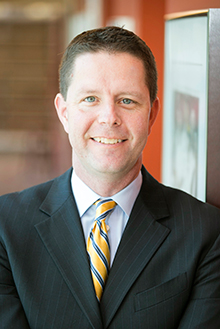
Timothy Holbrook
The reasoning of today's historic U.S. Supreme Court marriage ruling is much clearer than past decisions related to same-sex couples, leaving no question about the fundamental right to marry and the progress made by the LGBT community, according to Emory legal expert Tim Holbrook.
Holbrook serves as professor of law and associate dean of faculty for Emory Law. He has been an advocate for lesbian, gay, bisexual and transgender rights, including serving as co-counsel for former National Football League players in an amicus brief filed in 2013 as the Supreme Court weighed a challenge to California's Proposition 8, which halted same-sex marriages in the state.
On June 26, 2013, the Supreme Court ruled that plaintiffs who sought to defend the state ban did not have standing to bring the case, effectively clearing the way for same-sex couples to resume marrying in California. On the same day, the Supreme Court ruled in United States v. Windsor that the federal government had to recognize same-sex marriages from states where such unions are legal, but the justices left intact a portion of the Defense of Marriage Act that allowed states to refuse to recognize same-sex marriages.
Here is Holbrook's take on today's decision in the case of Obergefell v. Hodges, which went far beyond the Windsor decision by requiring states to allow same-sex couples to marry as well as recognize same-sex marriages from other states:
Marriage is a fundamental right that includes same-sex couples. So held the Supreme Court today in a 5-4 decision authored by Justice Anthony Kennedy. The outcome was expected by many. What was at issue, however, would be the reasoning. The lower courts, even those finding a constitutional right to same-sex marriage, had splintered as to the reason why such a right existed.
Much of this splintering was the result of Kennedy's previous decisions involving the rights of gays and lesbians. In striking down anti-sodomy laws in Lawrence v. Texas, Kennedy was a bit cagey, seemingly rooting the decision in the Due Process Clause, but never being explicit. His decision in United States v. Windsor was even more confusing, mixing concerns of dignity for same-sex couples with preservation of the states' prerogatives to regulate domestic relationships, including marriage.
In this context, however, the veil has been removed: marriage is a fundamental right that must include same-sex couples under the Due Process Clause.
While a powerful statement, it also helped the Court avoid dicier issues. For example, the Supreme Court has never determined whether sexual orientation should be treated as a "suspect class" under the Equal Protection Clause. If a government categorizes a group of people in a suspect class, such laws and regulations rarely survive scrutiny. While some of the lower courts had resolved the issue of marriage equality on this basis, the Court's decision to treat same-sex marriage as a fundamental right avoids this question for the time being.
Interestingly, all four dissenters wrote their own decisions in this case. All seemed concerned with the Court's disruption of the political process taking place, where states were debating same-sex marriage. The Court's decision undeniably disrupts that process. All of the dissenters noted future concerns with the intersection of same-sex marriage and religious freedoms and beliefs. Though Kennedy tried to assuage those concerns, the dissenters rightfully noted that conflict is likely to come down the pipeline.
Indeed, Chief Justice John Robert's dissent, taking the role from previous decisions by Justice Antonin Scalia, laid out many of the likely next legal challenges, including the issue of whether bans on polygamy can withstand constitutional challenge. All of these issues will be impacted by the Court's decision.
Finally, and importantly, is the rhetoric of all of these opinions. They are all respectful of gay and lesbian couples, which marks a sharp turn from the days of Bowers v. Hardwick and even Lawrence v. Texas. In this regard, the lesbian, gay, bisexual and transgender community has truly made progress.
